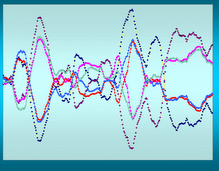As we will see the “Return to EMA 4” set-up doesn’t have to stop at EMA 4 it only has to return to at least EMA 4. While it always gets there sometimes it overshoots.
The set-up is simple – a stock price goes up abruptly in the first 15 minutes either as a gap up or as a straight shot higher from the previous day’s close. Here is an example in Goodyear (GT).

Note how Goodyear jumped up at the open and then slid sideways until it made contact with the EMA 4. At that point it printed a spinner (indecision) and on the very next candle made up its mind and away it went.
But how can you be sure – here is LPL

– same basic scenario – gap up, slide sideways down to EMA 4 and then start to go up but then flame out and go nowhere.
Well one way is to use the pivot point method with the Return to EMA 4. Here is GT with the pivot points.

You can see how it came back to the pivot point and then took off from the pivot point. So let's add a rule – must be in contact with one of the pivot points before a trade can be taken.
Here is LPL with the pivot points -

– and you can see that it is already above the second resistance and once that high there is no need to take the trade.
As I said in the introduction the price doesn’t necessarily have to stop at the 4 – it can continue on through to the EMA 21. Here is FRPT –

But look at FRPT with its pivot point –

Once more it hits the pivot and takes off. This time it comes back to the pivot once more before it finally makes the second pivot. I’ve also noted on this chart where a good spot for the stop loss might be – and that would be the next lowest pivot point.
One more example of going through the EMA 4 and this time it settled on the EMA 8. Here is KNOT –

And here’s KNOT with its pivot points

I had to annotate this chart with Midpoint High which is a valid pivot point that occurs half way between the actual pivot point itself and Resistance 1. And that is where KNOT chose to make its stand (or where the traders decided to start buying). You can usually "eyeball" midpoint high and low on the chart - it doesn't have to be precise.
I get my gap ups with a filter that I named “gap up” but that’s only because I’m not very creative. Prophet.net has a filtering capability that I can use but I prefer using Stockfetcher (even though it is 20 minutes delayed) because then I can write my own set-up and not just accept what the Prophet guys think I should use. The fact is the 20-minute delay is good (for me) because it keeps me from entering trades early in anticipation of what might happen rather than what actually happened. And yes I could probably find a better piece of software but this works for me, is reasonably priced, and I enjoy the little bit of work it takes to make it all come together. I am truly a hands-on kind of person – I like to see things working and not rely on some magical black box approach to trading.
Part 2 below has a few more examples for you to examine as well as a potential use for that pre-market data.























